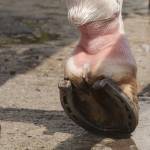Long Toes and Hindquarter Pain in Horses

Your horse has begun to stop at fences, is unwilling to move forward, has intermittent hind-leg lameness, and shows some signs of hindquarter pain or stiffness. Maybe he needs more frequent or different hoof care, according to research conducted at the College of Veterinary Medicine at North Carolina State University.
In the study, 77 horses (67 shod, 10 barefoot) were examined visually and by x-ray to measure toe length and coronary band angle in the hind hooves. An experienced veterinarian also palpated each horse’s hindquarters to determine the amount of pain in the gluteal muscle. A correlation was found between gluteal pain and a hoof angle known as long toe/low heel.
This hoof shape can be caused naturally by a horse’s conformation. It can also develop in horses that go too long between trimmings or even in horses that are trimmed every four to six weeks, generally considered to be an adequate frequency. The long toe/low heel hoof shape changes the angle of the pastern joint, putting strain on structures in the hind leg all the way up to the stifle and hip.
Horses that showed hindquarter pain had significantly longer toes than other horses in the study, and when the hooves were trimmed and shod to bring the hooves into balance, the pain was reduced or eliminated.
Richard Mansmann, V.M.D., Ph.D. led the study and explained that owners could estimate the hoof angle on their own horses by positioning the horse squarely and then visually extending the line of the rear coronary band toward the horse’s front end. Ideally, the imaginary line should touch the horse’s front leg between the elbow and the knee. If the line touches anywhere behind the elbow (near or behind the girth area), the hooves probably have a long toe/low heel shape.
Farriers can usually improve the hoof angle by trimming and corrective shoeing. Bringing the hooves into a more normal angle may relieve pain and stress on the hindquarters, though it could take several days to see improvement. Mansmann suggested considering the relationship of hoof shape to soundness and ability to perform if an owner noticed any stiffness, pain, or unwillingness to exercise freely. Because hoof angle is only one factor that can affect a horse’s soundness, a veterinary examination is advised any time a horse seems to have discomfort or a drop in performance.








